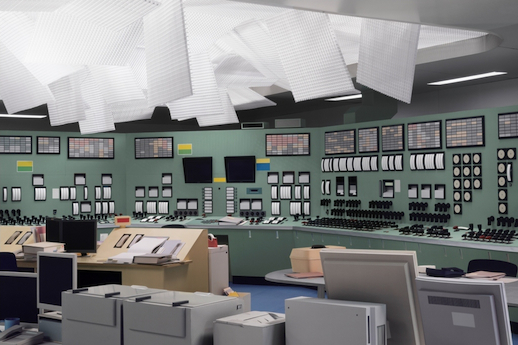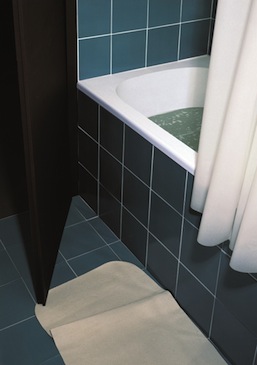Demand on “History”
What could link the Oval Office in Washington D.C., the bathroom of room 317 at the Hotel Beau-Rivage in Geneva, and the control room of the Fukushima Daiichi nuclear power plant? As historically relevant locations, each of these spaces is recognizable to large audiences worldwide, known via images disseminated in international mass media. Though the majority of us have never visited these places, and it is unlikely we ever will, we have an impression of their appearance: what the rooms look like, what they contain, their approximate dimensions. These conceptions have entered our memory by iconic photographs and have been integrated into our personal histories, likely stored in a vague yet resolute form. The fact that they are recognized by so many of us means that they can also be discussed as part of a collective memory. Can the same be said, however, for less specific views seemingly taken from daily life, such as unnamed photocopy shops or lawns?
In the first major retrospective of Thomas Demand’s work in Japan, simply titled “Thomas Demand” and currently on show at the Museum of Contemporary Art Tokyo, photography and film explore memory, temporality and “documentation” through photographs of reconstructed views. A mid-career contemporary artist of German origin, Demand is represented by the Taka Ishii Gallery in Japan, where he has had two solo shows, one in 2003 and another in 2007. Though he is internationally known, having lived and worked in London, Paris, Amsterdam, New York and L.A., this significant show at such a prominent Tokyo institution comes as quite a surprise, the artist lacking a visible following in Japan. This said, I can’t think of a better location for the world premiere of his work ‘Control Room’ (2011), a “constructed photograph” depicting the Fukushima Daiichi nuclear power plant control room several days after the March 11 earthquake hit, once the power supply had been reconnected.

An artist often on the move, Demand is concerned by “stuff”, the prospect of accumulating non-disposable objects posing a problem for him. From early on in his career, whilst he was still studying in Dusseldorf, he began to document his sculptures, soon valuing the photographs above the objects themselves. His transient lifestyle and the lightness of the work are evidently intertwined. Consequently, Demand is renowned for his large format photographs that document scenes from “history” that have entered themselves into his memory. To create these, he takes 2D views, often based on widely circulated press photographs, and reconstructs them in 3D via highly detailed life-sized models created from paper and cardboard. However, though there is an exacting precision in their construction, the models retain deliberate anachronisms and simplifications. This space is intentional and births a fissure between reality and fiction; it is a gap that cannot be readdressed or closed, as following the shoot the models are frequently destroyed without being displayed.
 Of the works on show, a large portion are politically charged, such as ‘Archive’ (1995), which depicts the store where Leni Riefenstahl’s controversial films are held, and ‘Bathroom’ (1997), inspired by the widely circulated image of Uwe Barschel, former minister-president of Schleswig-Holstein, Germany, as he was found dead in his Swiss hotel bathroom in October 1987. The group of five photographs titled ‘Presidency’, which are grouped together and set off from other works in the central exhibition space, are some of the most enigmatic images. Commissioned by The New York Times magazine, they depict the Presidential Oval Office in D.C. and were featured on the cover and in the November 9, 2008 issue of the magazine, released following the election of Barack Obama. With no access to the Oval Office, and given barely three weeks in which to complete the work, Demand produced the scale set based on six thousand-plus archive images he was given as reference. At an artist talk held on May 19, 2012, Demand commented on the fact that few readers of the magazine, possibly ten per cent at best, would even have noticed that these restaged images, which depict no specific single term of Presidency, were not photographs of the real thing. Seeing them displayed in full scale, it is hard to imagine that readers would not have noticed the confetti carpet or the faceless silhouettes in the framed pictures. It is also worth noting that these framed silhouettes are the closest things to people that appear in Demand’s images.
Of the works on show, a large portion are politically charged, such as ‘Archive’ (1995), which depicts the store where Leni Riefenstahl’s controversial films are held, and ‘Bathroom’ (1997), inspired by the widely circulated image of Uwe Barschel, former minister-president of Schleswig-Holstein, Germany, as he was found dead in his Swiss hotel bathroom in October 1987. The group of five photographs titled ‘Presidency’, which are grouped together and set off from other works in the central exhibition space, are some of the most enigmatic images. Commissioned by The New York Times magazine, they depict the Presidential Oval Office in D.C. and were featured on the cover and in the November 9, 2008 issue of the magazine, released following the election of Barack Obama. With no access to the Oval Office, and given barely three weeks in which to complete the work, Demand produced the scale set based on six thousand-plus archive images he was given as reference. At an artist talk held on May 19, 2012, Demand commented on the fact that few readers of the magazine, possibly ten per cent at best, would even have noticed that these restaged images, which depict no specific single term of Presidency, were not photographs of the real thing. Seeing them displayed in full scale, it is hard to imagine that readers would not have noticed the confetti carpet or the faceless silhouettes in the framed pictures. It is also worth noting that these framed silhouettes are the closest things to people that appear in Demand’s images.
Though Demand’s works are context-heavy, we are left ourselves to fill in the background of the events or locations represented. In the exhibition, brief information is offered in a handout, but is not visibly present in the museum space itself. The snippets of accompanying information almost read as though they are hearsay, making Demand’s entirely fabricated images feel as though they contribute to ever-evolving “histories”. However, it is unclear how much weight these largely European or U.S.-centered narrative images hold for a Japanese audience. ‘Control Room’ may be key here.
In addition to this, the less politicized images could well be more universal in their draw. Works such as ‘Lawn’ (1998) and ‘Laboratory’ (2000) offer less specific points of reference. Demand says of ‘Copyshop’ (1999) in the exhibition catalogue that he searched out a photograph he felt “achieved a certain generality”. More than the overtly politically or emotionally charged photographs, such pieces, with their unsettling simplicity of lines and gentle abstraction, emanate oscillating senses of denseness and lightness that are hard to pin down. Furthermore, there is something nostalgic about images like ‘Copyshop’ that give pride to objects soon to be obsolete. Tensions between the worlds of the analogue and the digital are also played out in his choice of materials. In this way, there is a fundamental reflectivity activated in the viewer.
By revisiting memories that previously appear to have been fixed by their photographic documentation, or by activating audiences to think more about their surroundings, Demand opens up for forum of discussion and encourages us to revisit and reassess both our collective and individual histories, past and present.
Jessica Jane Howard
Jessica Jane Howard



